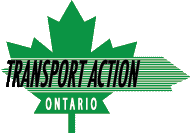By
Transport Action Ontario
|
Intercity Rail and Bus ,
Latest News
Transport Action Canada (TAC) is supporting and working with geographer Sean Marshall to improve Canadians’ knowledge about where intercommunity bus routes operate and where there are gaps in the bus and train network.
Sean presented an update of his work at the TAC Annual General Meeting in Kingston, Ontario on April 5, 2025. He discussed:
- The importance of intercommunity buses
- Changes between 1983 and now
- Mapping Canada’s intercommunity bus links – features and challenges
His presentation is attached to this posting.
The map can be viewed at: https://www.transportaction.ca/canada-intercity-transportation-map/
We encourage operators to send us their updates, and the map will be updated at least quarterly.
This is only a first step in improving Canada’s intercommunity bus network. Transport Action’s plan is to continue to advocate for filling gaps in routes, using joint stations (ideally with VIA Rail and local transit operators), schedule coordination between carriers, central booking of tickets and through-ticketing. We are also working with other on-line bus services like BusBud and Betterez to integrate platforms to provide complete planning and travel information in one website location.
Photograph: Prevost H3-45 motorcoach by Jason Lawrence CC BY 2.0






